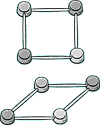|

Stretching and squashing -- some basic principles
Even though your gumdrop structures are standing
absolutely still, their parts are always pulling and pushing on
each other. Structures remain standing because some parts are
being pulled or stretched and other parts are being pushed or
squashed. The parts that are being pulled are in tension. The
parts that are being squashed are in compression.
Sometimes you can figure out whether something
is in tension or compression by imagining yourself in that object's
place. If you're a brick and someone piles more bricks on you,
you'll feel squashed�you're in compression. If you're a long steel
cable attached to a couple of towers and someone hangs a bridge
from you, you'll feel stretched -- you're in tension.
Some materials -- like bricks -- don't squash
easily; they are strong in compression. Others -- like steel cables
or rubber bands -- don't break when you stretch them; they are
strong under tension. Still others -- like steel bars or wooden
toothpicks -- are strong under both compression and tension.
What's the big deal about triangles?
 As
you've probably already discovered, squares collapse easily under
compression. Four toothpicks joined in a square tend to collapse
by giving way at their joints, their weakest points. A square
can fold into a diamond, like this:
As
you've probably already discovered, squares collapse easily under
compression. Four toothpicks joined in a square tend to collapse
by giving way at their joints, their weakest points. A square
can fold into a diamond, like this:
But if you make a toothpick triangle, the situation
changes. The only way to change the angles of the triangle is
by shortening one of the sides. So to make the triangle collapse
you would have to push hard enough to break one of the toothpicks.
 If
you want to, you can use your gumdrops and toothpicks to build
some strong structures that are made by combining triangles and
squares. The pattern on the left is one that's similar to some
used in modern bridge design.
If
you want to, you can use your gumdrops and toothpicks to build
some strong structures that are made by combining triangles and
squares. The pattern on the left is one that's similar to some
used in modern bridge design.
Looking for other triangles in structures around
you may give you ideas for other designs you can build with gumdrops
and toothpicks.
|